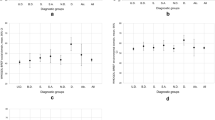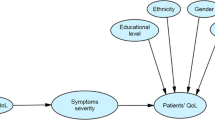Abstract
Objectives
We focused on the subjective quality of life (QOL) indicators of the Lancashire quality of life profile, European version (LQoLP-EU) in a Kuwaiti schizophrenia sample. The objectives were: First, to assess the reliability and validity of the questionnaire. Second, to highlight the patients’ QOL profile, in comparison with the results of the European five-nation study. Third, to examine the association of perceived needs for care, caregiver burden, service satisfaction, self-esteem and psychopathology, with three indices of global QOL: total life satisfaction or perceived QOL (PQOL) score; general wellbeing (GW) and Cantril’s ladder (CL).
Method
Consecutive outpatients in stable condition and their family caregivers were interviewed with the LQoLP, and measures of needs for care, service satisfaction, caregiver burden and psychopathology.
Results
There were 130 patients (66.1%m, mean age 36.8). Majority of the patients (56%) felt satisfied with the nine domains of life investigated, and 44.6% felt “averagely” happy. Their clinical severity was moderate (BPRS-18 = 44.4). In exploratory factor analysis (FA), the original domains were mostly replicated. Reliability indices were significant (>0.7). In stepwise regression analyses, the associations of PQOL were more in number and mostly different from those of GW and CL. The correlates of PQOL included, social unmet need (8.1% of variance), staff perception of unmet need (10.3%), general satisfaction with services (11.3%), burden of caregiver supervision (3.7%), self-esteem (2.9%) and positive symptoms (2.6%). Of the nine life domains, health was the most important correlate of GW and CL, indicating the centrality of health status in judgments of subjective QOL. In secondary FA, GW and CL loaded together, but separately from life domains, implying that these are separable parts of the subjective wellbeing construct.
Conclusion
The profile of QOL scores was mostly similar to European data. The significant multivariate association with patients/staff perceptions of unmet need for care and service satisfaction indicate the usefulness of staff professional development and service improvement in outcome; and imply that promotion of QOL should be an institutional objective. Our finding about the relationship between the three global measures of QOL has added support to the emerging QOL theory.
Similar content being viewed by others
References
Aaronson NK, Ahmedzai S, Bergman B, Bullinger M, Cull A, Duez NJ, Filiberti A, Flechtner H, Fleishman SB, de Haes JC (1993) The European Organization for Research and Treatment of Cancer QLQ-C30: a quality-of-life instrument for use in international clinical trials in oncology. J Natl Cancer Inst 85:365–376
Alshubaili AF, Awadalla AW, Ohaeri JU, Mabrouk AA (2007) Relationship of depression and disability with the quality of persons with multiple sclerosis. BMC Neurol 7:31. doi:10.1186/1471-2377-7-31
Alshubaili AF, Ohaeri JU, Awadalla AW, Mabrouk AA (2008) Family caregiver quality of life in multiple sclerosis among Kuwaitis: a controlled study. BMC Health Serv Res 8:206. doi:10.1186/1472-6963-8-206
American Psychiatric Association (1994) Diagnostic and statistical manual of mental disorder, 4th edn. American Psychiatric Association, Washington
Anderson KL, Burckhardt CS (1999) Conceptualization and measurement of quality of life as an outcome variable for health care intervention and research. J Adv Nurs 29:298–306
Awadalla AW, Ohaeri JU, Salih AA, Tawfiq AM (2005) Subjective quality of life of community living Sudanese psychiatric patients: comparison with caregivers’ impression and control group. Qual Life Res 14:1855–1867
Awadalla AW, Ohaeri JU, Salih AA, Tawfiq AM (2005) Subjective quality of life of family caregivers of community living Sudanese psychiatric patients. Soc Psychiatry Psychiatr Epidemiol 40:755–763
Bechdolf A, Klosterkotter J, Hambrecht M, Knoost B, Kuntermann C, Schiller S et al (2003) Determinants of subjective quality of life in post acute patients with schizophrenia. Eur Arch Psychiatry Clin Neurosci 253:235–328
Becker T, Knapp M, Knudsen HC, Schene AH, Tansella M, Thornicroft G, Vazquez-Barquero JL, The EPSILON Study Group (2000) Aims, outcome measures, study sites and patient sample. Br J Psychiatry 177(Suppl 39):s1–s7
Becker T, Leese M, Krumm S, Ruggeri M, Vazquez-Barquero JL, The EPSILON Study Group (2005) Needs and quality of life among patients with schizophrenia in five European centres. What is the impact of global functioning scores? Soc Psychiatry Psychiatr Epidemiol 40:628–634
Bjordal K, de Graeff A, Fayers PM, Hammerlid E, van Pottelsberghe C, Curran D, Ahlner-Elmqvist M, Maher EJ, Meyza JW, Brédart A, Söderholm AL, Arraras JJ, Feine JS, Abendstein H, Morton RP, Pignon T, Huguenin P, Bottomly A, Kaasa S, EORTC Quality of Life Group (2000) A 12-country field study of the EORTC QLQ-C30 (version 3.0) and the head and neck cancer specific module (EORTC QLQ-H&N35) in head and neck patients. Eur J Cancer 36:1796–1807
Cantril H (1965) The pattern of human concerns. Rutgers University Press, New Brunswick
Carr AJ, Higginson IJ (2001) Are quality of life measures patient centred? BMJ 322:1357–1360
Cheng S (1988) Subjective quality of life in the planning and evaluation of programs. Eval Program Plann 11:123–134
Chisholm D, Knapp MRJ, Knudsen HC, Amaddeo F, Gaite L, van Wijngaarden B, The EPSILON Study Group (2000) Client socio-demographic and service receipt inventory—European version: development of an instrument for international research. Br J Psychiatry 177(Suppl 39):s28–s33
Corring DJ (2002) Quality of life: perspectives of people with mental illnesses and family members. Psychiatr Rehabil J 25:350–358
Corring DJ, Cook JV (2007) Use of qualitative methods to explore quality of life. Psychiatr Serv 58:240–244
Cummins RA (2005) Moving from the quality of life concept to a theory. J Intellect Disabil Res 49(Pt 10):699–706
Diener E, Suh E, Lucas RE, Smith HL (1999) Subjective well-being: three decades of progress. Psychol Bull 125:276–302
Fujita F, Diener E (2005) Life satisfaction set point: stability and change. J Pers Soc Psychol 88:158–164
Gaite L, Vazquez-Barquero JL, Arrizabalaga AA, Schene A, Welcher B, Thornicroft G, Ruggeri M, Vazquez–Bourgon E, Retuerto MP, Leese M, The EPSILON Study Group (2000) Quality of life in schizophrenia: development, reliability and internal consistency of the Lancashire quality of life profile-European version. Br J Psychiatry 177(Suppl 39):s49–s54
Gaite L, Vazquez-Barquero JL, Borra C, Ballesteros J, Schene A, Welcher B et al (2002) Quality of life in patients with schizophrenia in five European countries: the EPSILON study. Acta Psychiatr Scand 105:283–292
Goldberg D, Williams P (1988) A user’s guide to the general health questionnaire. NFER-Nelson, Windsor
Hansson L, Sandlund M, Bengtsson–Tops A, Bjarnason O, Karlsson H, Mackeprang T, Merinder L, Nilsson L, Sorgaard K, Vinding H, Middleboe T (2003) The relationship of needs and quality of life in persons with schizophrenia living in the community. A Nordic multi-center study. Nord J Psychiatry 57:5–11
Junca A, Ustun TB, Early TS, Sartorious N (1993) The ICD-10 symptom checklist: a comparison to the ICD-10 classification of mental and behavioural disorders. Soc Psychiatry Psychiatr Epidemiol 28:239–242
Kemmler G, Holzner B, Neudorfer C, Meise U, Hinterhuber H (1997) General life satisfaction and domain-specific quality of life in chronic schizophrenia patients. Qual Life Res 6:265–273
Lasalvia A, Bonetto C, Malchiodi F, Salvi G, Parabiaghi A, Tansella M, Ruggeri M (2005) Listening to patients’ needs to improve their subjective quality of life. Psychol Med 35:1655–1665
Lehman AF (1983) The effects of psychiatric symptoms on quality of life assessments among chronic mentally ill. Eval Program Plann 6:143–151
Leplege A, Hunt S (1997) The problem of quality of life in medicine. JAMA 278:47–50
Leucht S, Kane JM, Kissling W, Hamann J, Etschel E, Engel R (2005) Clinical implications of brief psychiatric rating scale scores. Br J Psychiatry 187:366–371
McCrone P, Lesse M, Thornicroft G, Schene AH, Knudsen HC, Vazquez-Barquero JL, Lassalvia A, Padfield S, White IR, Griffiths G, The EPSILON Study Group (2000) Reliability of the Camberwell assessment of need-European version. Br J Psychiatry 177(Suppl 39):s34–s40
Meijer CJ, Schene AH, Koeter MWJ (2002) Quality of life in schizophrenia measured by the MOS SF-36 and the Lancashire quality of life profile: a comparison. Acta Psychiatr Scand 105:293–300
Meijer CJ, Koeter MWJ, Sprangers MAG, Schene AH (2008) Predictors of general quality of life and the mediating role of health related quality of life in patients with schizophrenia. Soc Psychiatry Psychiatr Epidemiol. doi:10.1007/s00127-008–0448-4
Narvaez JM, Twamley EW, McKibbin CL, Heaton RK, Patterson TL (2008) Subjective and objective quality of life in schizophrenia. Schizophr Res 98:201–208
Oliver JP (1991) The social care directive: development of a quality of life profile for use in community services for the mentally ill. Soc Work Soc Sci Rev 3:5–45
Oliver J, Huxley P, Priebe S et al (1997) Measuring the quality of life of severely ill people using the Lancashire quality of life profile. Soc Psychiatry Psychiatr Epidemiol 32:76–83
Ohaeri JU, Awadalla AW, Gado OM (2009) Subjective quality of life in a nationwide sample of Kuwaiti subjects using the short version of the WHO quality of life instrument. Soc Psychiatry Psychiatr Epidemiol 44:693–701
Packer S, Husted J, Cohen S, Tomlinson G (1997) Psychopathology and quality of life in schizophrenia. J Psychiatry Neurosci 22:231–234
Rosenberg M (ed) (1965) Society and the adolescent self-image. Princeton University Press, Princeton
Ruggeri M, Biggeri P, Rucci P, Tansella M (1998) Multivariate analysis of outcome of mental health care using graphical chain models. The South-Verona Outcome Project Psychol Med 28:1421–1431
Ruggeri M, Lassalvia A, Dall’Agnola R, van Wijngaarden B, Knudsen HC, Lesse M, Gaite L, Tansella M, The EPSILON Study Group (2000) Development, internal consistency and reliability of the Verona service satisfaction scale-European version. Br J Psychiatry 177(Suppl 39):s41–s48
Ruggeri M, Warner R, Biscoffi G, Fontecedro L (2001) Subjective and objective dimensions of quality of life in psychiatric patients: a factor analytic approach. Br J Psychiatry 178:268–275
Schimmack U, Diener E, Oishi S (2002) Life-satisfaction is a momentary judgment and a stable personality characteristic: the use of chronically accessible and stable sources. J Pers 70:345–384
Skevington SM, Lofty M, O’Connell KA (2004) The World Health Organization’s WHOQOL-Bref quality of life assessment: psychometric properties and results of the international field trial. A report from the WHOQOL group. Qual Life Res 13:299–310
Slade M, Leese M, Ruggeri M, Kuipers E, Tansella M, Thornicroft G (2004) Does meeting needs improve quality of life? Psychother Psychosom 73:183–189
Slade M, Leese M, Cahill S, Thornicroft G, Kuipers E (2005) Patient-rated mental health needs and quality of life improvement. Br J Psychiatry 187:256–261
Smith KW, Avis NE, Assmann SF (1999) Distinguishing between quality of life and health status in quality of life research: a meta-analysis. Qual Life Res 8:447–459
Sprangers MA, Schwartz CE (2008) Reflections on changeability versus stability of health-related quality of life: distinguishing between its environmental and genetic components. Health Qual Life Outcomes 6(1):89
van Nieuwenhuizen Ch, Schene A, Koeter MW, Huxley PJ (2001) The Lancashire quality of life profile: modification and psychometric evaluation. Soc Psychiatry Psychiatr Epidemiol 36:36–44
van Wijngaarden B, Schene A, Koeter M, Vazquez-Barquero JL, Kundsen HC, Lassalvia A, McCrone P, The EPSILON Study Group (2000) Caregiving in schizophrenia: development, internal consistency and reliability of the involvement evaluation questionnaire-European version. Br J Psychiatry 177(Suppl 39):s21–s27
Ventura J, Green MF, Shaner A, Liberman RP (1993) Training and quality assurance with the brief psychiatric rating scale: the drift busters. Int J Methods Psychiatr Res 3:244
Wiersman D, van Busschbach J (2001) Are needs and satisfaction of care associated with quality of life? An epidemiological survey among the severely mentally ill in the Netherlands. Eur Arch Psychiatry Clin Neurosci 251:239–246
Wiersma D (2006) Needs of people with severe mental illness. Acta Psychiatr Scand 113(Suppl 429):115–119
Zissi A, Barry MM, Cochrane R (1998) A mediational model of quality of life for individuals with severe mental health problems. Psychol Med 28:1221–1230
Acknowledgments
This study was funded by Kuwait University Grant Number: MQ01/05.
Conflict of interest statement
The authors declare no conflict of interest.
Author information
Authors and Affiliations
Corresponding author
Rights and permissions
About this article
Cite this article
Zahid, M.A., Ohaeri, J.U., Elshazly, A.S. et al. Correlates of quality of life in an Arab schizophrenia sample. Soc Psychiat Epidemiol 45, 875–887 (2010). https://doi.org/10.1007/s00127-009-0131-4
Received:
Accepted:
Published:
Issue Date:
DOI: https://doi.org/10.1007/s00127-009-0131-4




